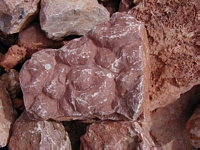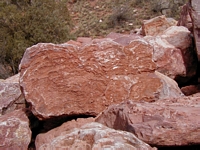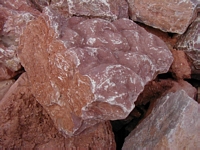Stromatolites:
Fossilized Algal Mats
(or Bacterial Mats) in the
Lykins formation
which formed sometime around the Permian/Triassic boundary (apx. 250 mya);
found
at a construction site in the Front Range area, Colorado, USA |
In almost every photo there is a United States quarter (25 cent
piece) as a reference (I did not have my GSA scale/marker with me at the
time). Click on
any thumbnail photo on this page to open the full-sized image in
your browser. You will then have to hit the back button to get
back to this page to view the others. All photos are 1280x960
(and were
taken around noon on April 6th, 2001).
|
|
In these two photos of this piece, the arched, layered
structure of the mat can be seen in cross-section.
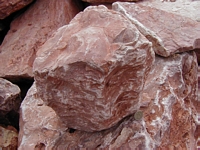
image13.jpg
205.5 KB
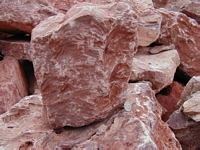
image12.jpg
208.0 KB
|
|
|
|
How?
They were formed (passively) by the
accidental cooperation between either Cyanobacteria or some kind of Algae or
other Algae-like
organisms and sediments washed in at the edge of a lake or
sea.
The organisms form a slimy film on the top of whatever they are
growing on.
The material which makes up this sedimentation (which may have
eroded from the "Ancestral Rockies" in this case, one of the ranges
which preceded the present day Rocky Mountains) was deposited
layer after layer, day after day as it was washed over and stuck
to the slimy coating of organisms.
The slimy film would get covered over by the sediments brought by
the water lapping over the mounds.
New ones would grow up through the layers of silt and sand to
again form the slimy, sticky film . . . and so on, and so on, and so on. |
|
|
When?
Based on a geologic map of the area in which I found these stromatolites, it
appears that they are in the Lykins formation which formed around the time of
the Great Permian Extinction, 250 million years ago, at the Permian/Triassic
boundary.
Some experts list the Lykins formation as occurring during the late
Permian period while others list it either during the early Triassic
or overlapping
the two. Since I'm not an expert in geologic ages, I
just say that this formation was laid down at the
Permian/Triassic boundary.
Where?
Geological data on this formation tells that it formed in a marginal marine
environment (where the land meets a large body of water such as an ocean or
sea).
Perhaps the slimy community which created these structures was in or near the shallow waters
of one edition or another of a great inland sea which has covered much of
central North America from time to time throughout the ages. |
|
|
This piece of rock is right-side up and the photo
shows a good view of the convex structure of the top of the mat.
There is another piece, near the bottom of this page, which is
up-side down, showing the concave under-side of the arched structure
of this mat.
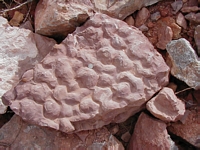
image02.jpg
205.7 KB |
|
|
|
These 3 show another very good top-side view of
the convex structures of the mat as well as cross-section views of
the same piece. The third photo of this piece shows the correlation
between the progressively
upward layering and the resulting convex
structures on top. |
|
|
|
Interesting related
facts...
As I said above, these particular stromatolites were formed fairly
recently in the history of life's evolution on Earth (only 250 million
years ago). However, they are similar to and a good example of the oldest
fossils we have found.
The oldest fossils from any living organism known on Earth (from apx. 3.5 billion
years ago) are from an
organism similar to (or perhaps the same as) what was responsible for these stromatolites. It is called Cyanobacteria
(once known as
Blue-Green Algae).
These organisms are actually photosynthetic (can turn sun-light into food/energy). Remember... this means that they produce oxygen as a
by-product.
In light of the vast areas of our planet that were once covered by these organisms (their
fossilized mounds can be found in almost every region on Earth, and some
are still being formed today in various places), they are most
likely responsible for much of Earth's early, oxygen-rich atmosphere...
...which produced an ozone layer
...which resulted in blocking out a great deal of the sun's ultraviolet
light
...which led to a better environment (less ultraviolet radiation = higher
survival rate) for plants and animals of various
kinds to start coming up onto and making a foothold on the land ...etc ...etc ...
...which would eventually be capitalized on by air breathing land creatures
such as our selves |
This is the up-side down piece i mention close to the
top of this page.
|
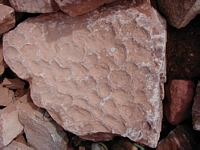
image38.jpg
200.3 KB |
They are not
just weathered this way or marks from something else making an
indentation.
|
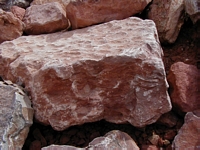
image40.jpg
204.9 KB |
Again, in this photo, the layering is very obvious. |
|
I found these at a construction site (after much tossing around). So, they are not exactly museum-quality
specimens. Most of what I found here are relatively small pieces due to being
part of a house building project . . . specifically, being the part of the
ground that needed to be dug up and discarded in order to fit the house in
there. I was originally there just taking landscape and scenery photos. When I
saw what looked like some sort of stromatolites from a distance, I decided to
investigate a bit further.
At one point I spoke with the owners of the project and they
said it was ok for me to roam around, look at and photograph all I wanted. They
even let me take some of the fossil mat material to keep in my own fossil
display case at home. I also had a couple of pieces cut in order to see a
better, cleaner cross-section, and had a thin-slice made (at the University
of Colorado at Boulder) to examine it under a microscope (not much for my as-yet
untrained eyes to get excited about, but it's still neat). Some day I will have
photos of those cut pieces up here as well (a digital microscope is in the
future).
If you would like to join me (or just help me) in my process of studying and learning
about the these particular fossil stromatolites or any other fossils (on this site or
elsewhere), please contact me at the e-mail address located on my
contact page.
Thank you for taking a look.
back to my
home page contact
me . . .



